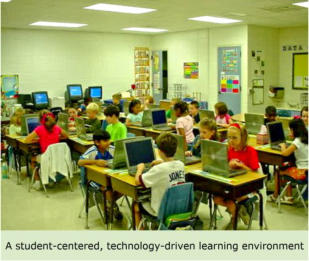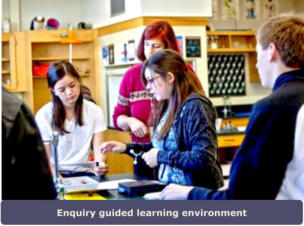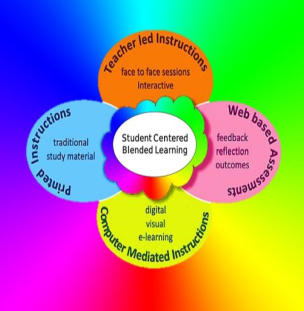



Contd. on VI. The Need for Technology

ASMIS Dream Curriculum
- In the light of an ever growing competitive
technology-driven global economy -
Several learning approaches have emerged in response to the quest of governments and industries obsessed
to the quest of governments and industries obsessed  for a competitive edge in the global market of goods
for a competitive edge in the global market of goods services and ideas. Among the more popular we read
services and ideas. Among the more popular we read about are the student-centered learning approach,
about are the student-centered learning approach, learning by inquiry, progressive method and a blend of
learning by inquiry, progressive method and a blend of the teacher-centered and student-centered learning
the teacher-centered and student-centered learning approaches. ASMIS and the Philippines’ K-12 program
approaches. ASMIS and the Philippines’ K-12 program  adopted the student-centered learning approach.
Viewed in the context of a nation’s or industry’s
adopted the student-centered learning approach.
Viewed in the context of a nation’s or industry’s economic standpoint, these learning approaches seek
economic standpoint, these learning approaches seek to foster the factor-determinants of the competitive
to foster the factor-determinants of the competitive edge equation. These include the following:
1. Innate talents of the learner/student. Students
edge equation. These include the following:
1. Innate talents of the learner/student. Students are endowed with different talents. Some are good in
are endowed with different talents. Some are good in math and science; some are good in music and the
math and science; some are good in music and the arts; some are good in law. Students/learners who are
arts; some are good in law. Students/learners who are guided to develop their innate talents to the greatest
guided to develop their innate talents to the greatest extent possible are most likely to have greater impact
extent possible are most likely to have greater impact in an industry’s, government ‘s or nation’s quest for a
in an industry’s, government ‘s or nation’s quest for a competitive edge in the global market place of goods,
competitive edge in the global market place of goods, services and ideas.
2. Innovative. Innovations can keep an industry,
services and ideas.
2. Innovative. Innovations can keep an industry, government, or nation ahead of competitors. That is
government, or nation ahead of competitors. That is why innovative individuals are prime targets of
why innovative individuals are prime targets of manpower resources development and recruitment
manpower resources development and recruitment programs.
programs.  3. Results Oriented. Knowledge accumulation is
3. Results Oriented. Knowledge accumulation is good; but knowlege application is better. It is the
good; but knowlege application is better. It is the application of knowledge that generates and/or
application of knowledge that generates and/or improve a good or service.
4. Team Player or Collaborative. Majority of goods
improve a good or service.
4. Team Player or Collaborative. Majority of goods and services are the product of several individuals, a
and services are the product of several individuals, a team. The better the team play, the better are the
team. The better the team play, the better are the chances of out-competing competitiors.
5. Digitized Communication Skills. Computers,
chances of out-competing competitiors.
5. Digitized Communication Skills. Computers, digital communications and related technology can
digital communications and related technology can make work environments and procedures faster, safer
make work environments and procedures faster, safer and more economical.
and more economical. 6. Sensitive to Cultural, Religious and Environ-
6. Sensitive to Cultural, Religious and Environ- mental Concerns. Mega million projects have been
mental Concerns. Mega million projects have been torpedoed by insensitivity to cultural practices,
torpedoed by insensitivity to cultural practices, religious beliefs or environmental concerns. Thus,
religious beliefs or environmental concerns. Thus, cultural practices, religious beliefs and environmental
cultural practices, religious beliefs and environmental concerns are integral components in feasibility project
concerns are integral components in feasibility project studies or cost-benefit analysis.
7. Values Formation. Corruption whether in govern-
studies or cost-benefit analysis.
7. Values Formation. Corruption whether in govern- ment or the private sector is a deterrent to the
ment or the private sector is a deterrent to the efficient use of the factors of production. Many times
efficient use of the factors of production. Many times we have seen the cost of a project blown to
we have seen the cost of a project blown to uneconomical proportions by greedy individuals. These
uneconomical proportions by greedy individuals. These individuals have become callouse to universal values
individuals have become callouse to universal values such as: “Thou shall not steal”; “Do not do unto others
what you don’t want others do unto you”. The best
such as: “Thou shall not steal”; “Do not do unto others
what you don’t want others do unto you”. The best hope of regaining and or strengthening values are the
hope of regaining and or strengthening values are the youth.
8. Love of country or ethnic roots. Love of country
youth.
8. Love of country or ethnic roots. Love of country or ethnic roots can inspire a people to produce and
or ethnic roots can inspire a people to produce and defend what is right for themselves. Unpatriotic
defend what is right for themselves. Unpatriotic individuals are easy prey for subjugation. One who has
individuals are easy prey for subjugation. One who has no pride for his people will likely hide in the shadows
no pride for his people will likely hide in the shadows and not join in efforts to improve their plight.
and not join in efforts to improve their plight. It is our dream that ASMIS will soon be equipped with
It is our dream that ASMIS will soon be equipped with the faculty training and facilities for an honest-to-
the faculty training and facilities for an honest-to- goodness implementation of the student-centered
goodness implementation of the student-centered learning approach.
learning approach.
 to the quest of governments and industries obsessed
to the quest of governments and industries obsessed  for a competitive edge in the global market of goods
for a competitive edge in the global market of goods services and ideas. Among the more popular we read
services and ideas. Among the more popular we read about are the student-centered learning approach,
about are the student-centered learning approach, learning by inquiry, progressive method and a blend of
learning by inquiry, progressive method and a blend of the teacher-centered and student-centered learning
the teacher-centered and student-centered learning approaches. ASMIS and the Philippines’ K-12 program
approaches. ASMIS and the Philippines’ K-12 program  adopted the student-centered learning approach.
Viewed in the context of a nation’s or industry’s
adopted the student-centered learning approach.
Viewed in the context of a nation’s or industry’s economic standpoint, these learning approaches seek
economic standpoint, these learning approaches seek to foster the factor-determinants of the competitive
to foster the factor-determinants of the competitive edge equation. These include the following:
1. Innate talents of the learner/student. Students
edge equation. These include the following:
1. Innate talents of the learner/student. Students are endowed with different talents. Some are good in
are endowed with different talents. Some are good in math and science; some are good in music and the
math and science; some are good in music and the arts; some are good in law. Students/learners who are
arts; some are good in law. Students/learners who are guided to develop their innate talents to the greatest
guided to develop their innate talents to the greatest extent possible are most likely to have greater impact
extent possible are most likely to have greater impact in an industry’s, government ‘s or nation’s quest for a
in an industry’s, government ‘s or nation’s quest for a competitive edge in the global market place of goods,
competitive edge in the global market place of goods, services and ideas.
2. Innovative. Innovations can keep an industry,
services and ideas.
2. Innovative. Innovations can keep an industry, government, or nation ahead of competitors. That is
government, or nation ahead of competitors. That is why innovative individuals are prime targets of
why innovative individuals are prime targets of manpower resources development and recruitment
manpower resources development and recruitment programs.
programs.  3. Results Oriented. Knowledge accumulation is
3. Results Oriented. Knowledge accumulation is good; but knowlege application is better. It is the
good; but knowlege application is better. It is the application of knowledge that generates and/or
application of knowledge that generates and/or improve a good or service.
4. Team Player or Collaborative. Majority of goods
improve a good or service.
4. Team Player or Collaborative. Majority of goods and services are the product of several individuals, a
and services are the product of several individuals, a team. The better the team play, the better are the
team. The better the team play, the better are the chances of out-competing competitiors.
5. Digitized Communication Skills. Computers,
chances of out-competing competitiors.
5. Digitized Communication Skills. Computers, digital communications and related technology can
digital communications and related technology can make work environments and procedures faster, safer
make work environments and procedures faster, safer and more economical.
and more economical. 6. Sensitive to Cultural, Religious and Environ-
6. Sensitive to Cultural, Religious and Environ- mental Concerns. Mega million projects have been
mental Concerns. Mega million projects have been torpedoed by insensitivity to cultural practices,
torpedoed by insensitivity to cultural practices, religious beliefs or environmental concerns. Thus,
religious beliefs or environmental concerns. Thus, cultural practices, religious beliefs and environmental
cultural practices, religious beliefs and environmental concerns are integral components in feasibility project
concerns are integral components in feasibility project studies or cost-benefit analysis.
7. Values Formation. Corruption whether in govern-
studies or cost-benefit analysis.
7. Values Formation. Corruption whether in govern- ment or the private sector is a deterrent to the
ment or the private sector is a deterrent to the efficient use of the factors of production. Many times
efficient use of the factors of production. Many times we have seen the cost of a project blown to
we have seen the cost of a project blown to uneconomical proportions by greedy individuals. These
uneconomical proportions by greedy individuals. These individuals have become callouse to universal values
individuals have become callouse to universal values such as: “Thou shall not steal”; “Do not do unto others
what you don’t want others do unto you”. The best
such as: “Thou shall not steal”; “Do not do unto others
what you don’t want others do unto you”. The best hope of regaining and or strengthening values are the
hope of regaining and or strengthening values are the youth.
8. Love of country or ethnic roots. Love of country
youth.
8. Love of country or ethnic roots. Love of country or ethnic roots can inspire a people to produce and
or ethnic roots can inspire a people to produce and defend what is right for themselves. Unpatriotic
defend what is right for themselves. Unpatriotic individuals are easy prey for subjugation. One who has
individuals are easy prey for subjugation. One who has no pride for his people will likely hide in the shadows
no pride for his people will likely hide in the shadows and not join in efforts to improve their plight.
and not join in efforts to improve their plight. It is our dream that ASMIS will soon be equipped with
It is our dream that ASMIS will soon be equipped with the faculty training and facilities for an honest-to-
the faculty training and facilities for an honest-to- goodness implementation of the student-centered
goodness implementation of the student-centered learning approach.
learning approach.




































